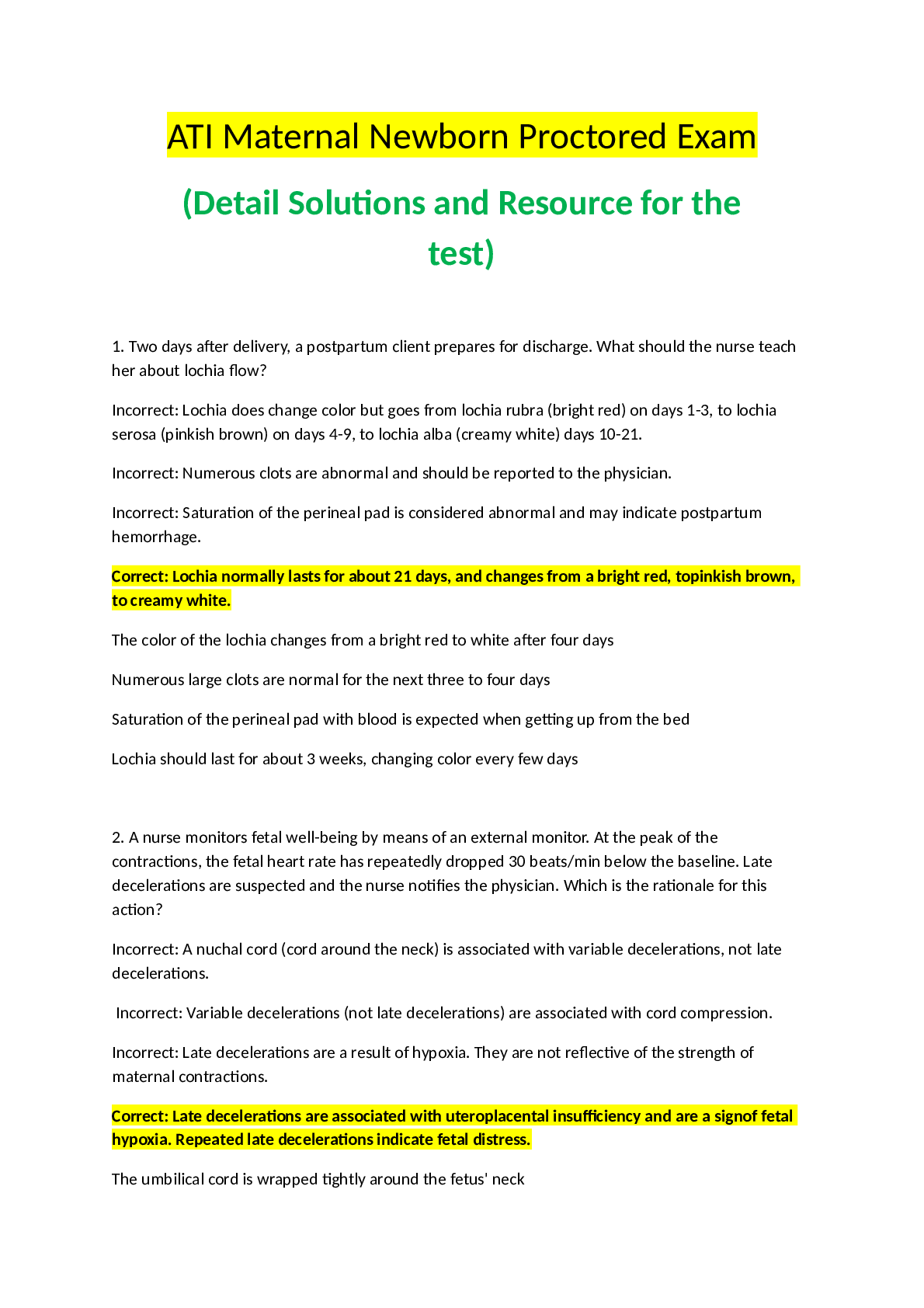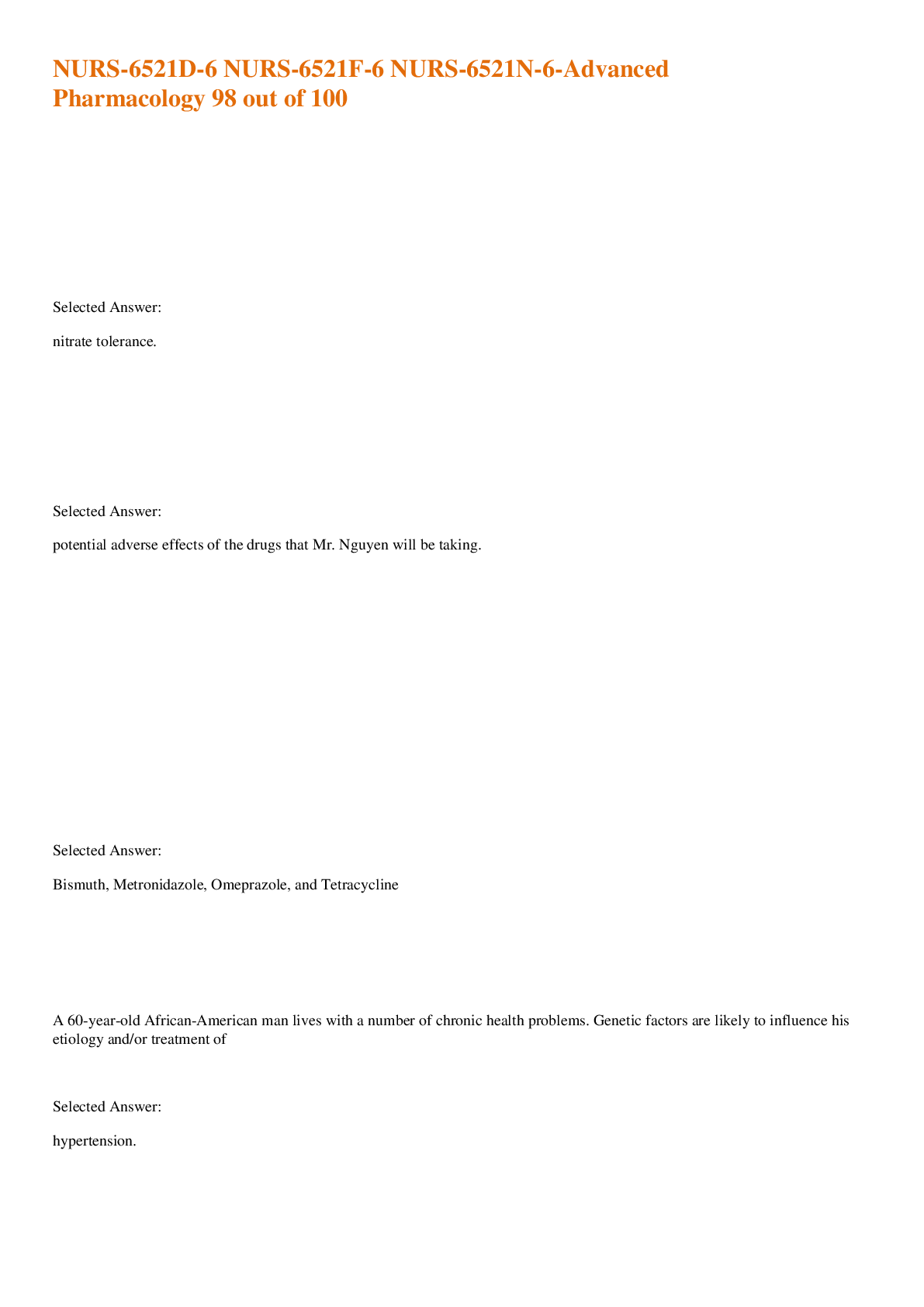*NURSING > QUESTIONS & ANSWERS > NR507 FINAL EXAM LATEST UPDATED 2021 A+ GRADED (All)
NR507 FINAL EXAM LATEST UPDATED 2021 A+ GRADED
Document Content and Description Below
Question 1 2 / 2 pts Tissue damage caused by the deposition of circulating immune complexes containing an antibody against the host DNA is the cause of which disease? Hemolytic anemia Pernicious ... anemia Systemic lupus erythematosus Myasthenia gravis Only the deposition of circulating immune complexes containing an antibody against the host DNA produce tissue damage in individuals with systemic lupus erythematosus (SLE). Question 2 2 / 2 pts How does chest wall compliance in an infant differ from that of an adult? An adult’s chest wall compliance is lower than an infant’s. An adult’s chest wall compliance is higher than an infant’s. An adult’s chest wall compliance is the same as an infant’s. An adult’s chest wall compliance is dissimilar to that of an infant’s. Chest wall compliance is higher in infants than it is in adults, particularly in premature infants. Question 3 2 / 2 pts What term is used to describe a hernial protrusion of a saclike cyst that contains meninges, spinal fluid, and a portion of the spinal cord through a defect in a posterior arch of a vertebra? Encephalocele Meningocele Spina bifida occulta Myelomeningocele Myelomeningocele is a hernial protrusion of a saclike cyst containing meninges, spinal fluid, and a portion of the spinal cord with its nerves through a defect in the posterior arch of a vertebra. The remaining options are not appropriate terms to identity the described condition. Question 4 2 / 2 pts Continued therapy of pernicious anemia (PA) generally lasts how long? 6 to 8 weeks 8 to 12 months Until the iron level is normal The rest of one’s life Because PA cannot be cured, maintenance therapy is a life-long endeavor. Question 5 2 / 2 pts Cytokines are thought to cause fevers by stimulating the synthesis of which chemical mediator? Leukotriene Histamine Prostaglandin Bradykinin Cytokines seem to raise the thermoregulatory set point through stimulation of prostaglandin synthesis and turnover in thermoregulatory (brain) and nonthermoregulatory (peripheral) tissues. The other options do not accurately identify the appropriate chemical mediator. Question 6 2 / 2 pts The World Health Organization (WHO) defines grade 1 (overweight) as a BMI of: 18.5 to 24.9 25 to 29.9 30 to 39.9 40 to 50.9 A BMI of 25 to 29.9 kg/m2 is considered a grade 1 (overweight) classification. A BMI of 18.5 to 24.9 kg/m2 is considered normal range, whereas 30 to 39.9 kg/m2 is a grade 2 (severe overweight) classification, and a BMI higher than 40 kg/m2 is considered grade 3 (morbidly overweight). IncorrectQuestion 7 0 / 2 pts When diagnosed with hemolytic disease of the newborn (HDN), why does the newborn develop hyperbilirubinemia after birth but not in utero? Excretion of unconjugated bilirubin through the placenta into the mother’s circulation is no longer possible. Hemoglobin does not break down into bilirubin in the intrauterine environment. The liver of the fetus is too immature to conjugate bilirubin from a lipid-soluble to water-soluble form. The destruction of erythrocytes producing bilirubin is greater after birth. Hyperbilirubinemia occurs in the neonate after birth because excretion of lipidsoluble unconjugated bilirubin through the placenta is no longer possible. This selection is the only option that accurately explains why HDN causes hyperbilirubinemia after birth but not in utero. Question 8 2 / 2 pts Which of the following describes how the body compensates for anemia? Increasing rate and depth of breathing Decreasing capillary vasoconstriction Hemoglobin holding more firmly onto oxygen Kidneys releasing more erythropoietin Tissue hypoxia creates additional demands and compensatory actions on the pulmonary and hematologic systems. The rate and depth of breathing increase in an attempt to increase the availability of oxygen. This selection is the only option that accurately describes the compensation mechanism in such anemias. Question 9 2 / 2 pts An infant has a continuous machine-type murmur best heard at the left upper sternal border throughout systole and diastole, as well as a bounding pulse and a thrill on palpation. These clinical findings are consistent with which congenital heart defect? Atrial septal defect (ASD) Ventricular septal defect (VSD) Patent ductus arteriosus (PDA) Atrioventricular canal (AVC) defect If pulmonary vascular resistance has fallen, then infants with PDA will characteristically have a continuous machine-type murmur best heard at the left upper sternal border throughout systole and diastole. If the PDA is significant, then the infant also will have bounding pulses, an active precordium, a thrill on palpation, and signs and symptoms of pulmonary overcirculation. The presentations of the other congenital heart defects are not consistent with the described the symptoms. Question 10 2 / 2 pts Research has shown a link between cancer and which sexually transmitted disease? Syphilis Gonorrhea Human papillomavirus Pelvic inflammatory disease [Show More]
Last updated: 1 year ago
Preview 1 out of 36 pages
Instant download

Buy this document to get the full access instantly
Instant Download Access after purchase
Add to cartInstant download
Reviews( 0 )
Document information
Connected school, study & course
About the document
Uploaded On
Jan 08, 2022
Number of pages
36
Written in
Additional information
This document has been written for:
Uploaded
Jan 08, 2022
Downloads
0
Views
34

.png)
.png)
.png)
.png)
.png)
.png)
.png)
.png)
.png)
.png)
.png)

.png)

.png)






.png)
.png)

